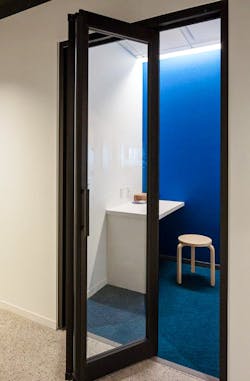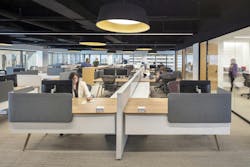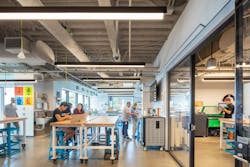Part I: Workplace Pre-Pandemic
Recently, the pandemic discussion has shifted from understanding the spread of the COVID-19 virus to considering when and how we will return to “normal” life, with much speculation over what the workplace will look like for office workers when they return. More likely than not, our collective return to physical offices will be a more nuanced reality than some headlines may suggest: a complex, amorphous recovery, different for each individual and company. Before speculating about the “evolution of work” and the “new office,” it is worth examining the recent history of workplace design.
The shift to open office design was largely driven by a change in the way we work. Our economy shifted from repetitive, production-focused work to innovative, knowledge-based work, which required that cubicle walls come down. As knowledge-based work increased with the explosion of the internet and globalization, employee interaction came to be viewed as an imperative, rather than a distraction hindering productivity.
Knowledge workers travel, spend a lot of time in meetings, and look for quiet places to focus and work. This mobility explains the widespread push for open-desks and hot-desking, the practice of providing fewer desks than the number of employees and seating people at unassigned desks. While many people believe moving to open office or unassigned seating requires less space than more traditional offices, the increased meeting spaces, collaboration areas, quiet areas, and social spaces typically require at least as much space. The innovative, collaborative office will still exist post-pandemic, but the implementation of these spaces will have to be addressed.
Part II: Workplace Post-Pandemic
Over time, slivers of “normal” life will be ours to claim again. Many economists and scientists project it may take upwards of 18 months to fully return to some semblance of normalcy. The return to the physical office will be dependent on many factors, including how safe people feel traveling to, and spending time in, the workplace.
Regardless of whether it takes 3 or 18 months to fully return to work, it is clear the long march toward re-emergence from this global pandemic will likely be more of a gradual re-opening than a simultaneous return to life as we knew it. The best thing we can do as a profession charged with designing workplaces for optimal experience and productivity is to approach this challenge with a clear-headed assessment of what may lie ahead, and flexible problem-solving that fits the specific, evolving needs of each client.
This may be the first global pandemic that has touched America so severely, but this is also a trial and an opportunity to be better prepared for a resurgence of the next pandemic that may befall us. With our interconnected modern world, the risk of global pandemics is a reality we must adapt to. We are social creatures and the drive to return to work is also a drive to return to social settings. Adaptations to places we frequent will help some in the short-term, but the long-term recovery will require we solve for a way to be together again—not just in the office, but also at backyard barbeques, restaurants, and sporting events.
The Home Will Not Become the Office Forever
In the whirlwind of COVID-19 Sasaki designers have come to a few shared realizations that cut across industries: we’ve learned how to implement technologies which have made work from afar possible—even for a collaboration-intensive industry like ours. At the same time, we’ve recognized there are limits to remote connection—collaboratively sketching a drawing simply cannot be replicated via a video call.
Many companies are likely experiencing similar revelations, which will result in workers desiring a return to the physical office, at least for part of the week. The flexibility offered by mass-adoption of new technologies, and perhaps more flexible policies around remote working, will change our experience and expectations for time in the office.
Almost everyone we have spoken with is excited about returning to work. Conversations are more effective in person, people are more active, and a lack of ergonomics at home are all motivating factors for a return to the office. It has become clear that for many, our homes weren’t meant for this lifestyle, and that home should be home and work should be work.
The Office Will Be Less Like the Home
Office design and programming has been increasingly influenced by home design, with a goal to make employees comfortable throughout the day. In physical workplaces, we anticipate a move away from the trend toward blending office and home. Many companies have tried to make their offices as comfortable and convenient as possible, offering amenities like round-the-clock free meals, dry cleaning, high-end gyms, fitness classes, childcare, nap rooms—all to keep employees happily at work. With the experience of working from home fresh in their minds, many employees may well come to appreciate just how important separation of work and home can be for mental health and well-being.
We may see the gradual decline of “resimercial” aesthetics in design, which has been a hot trend for years. “Resimercial” design blends residential design aesthetics into commercial environments, creating offices that look like living rooms and kitchens. The pandemic provides the opportunity to create a new language of workplace design, to envision something different. Office design doesn’t need to be cold and sterile but can be itself instead of channeling other spaces.
Layout and Flow
Open-office plans featuring large rooms full of open-office seating had already begun to fall out of favor prior to the pandemic, as companies have found the detriments to focus and productivity do not offset the cost-savings of tightly-packed desks. We have worked with many companies to create smaller “neighborhoods” or “pods” of agile seating, and teamwork rooms which allow for clusters with partially-assigned seats. We believe this approach will likely gain traction at an accelerated clip.
Travel will be limited, which will put an increased demand on video calls and meetings. Video calls were on the rise prior to the pandemic, but now companies will likely be looking to invest in more phone-rooms or small video call rooms, perhaps by converting larger meeting rooms into multiple, small video call rooms.
Newer technologies will bring people together. Sasaki has already begun experimenting with robots that allow workers to attend meetings via a mobile video screen, take a literal seat at the table in meetings, and roam around the office to engage in casual exchanges. Holographic phone calls are in development with Verizon, KT Telecom, and Vodaphone. These technologies may be everywhere soon, as advances could completely revolutionize our office environments in profound ways still unknown to us today.
As a short-term reaction to social distancing directives, some designers have begun advocating specific one-directional flow of traffic within offices, indicated by signage and floor cues. In our experience, directing human behavior-flow through design will not yield new long-term habits. Design has documented that people consistently choose the shortest route to their destination.
Hot-desking and Why We Won’t Return to Cubicles
Projections that this pandemic will spell the end of “hot-desking” at unassigned desks may be over-simplifying the discussion. The return to normal life will likely be in stages, with only a portion of people returning to the office at a time, either because they have been tested as immune or healthy, to manage social distancing, or because we developed a vaccine.
The reality of what is possible for any one company will depend on the workplace strategy created in their office. Many companies have switched to unassigned seating because their teams work from home or outside of the office part time. The short-term return to work could include a plan that brings employees into the office one or two days a week on a rotating basis. Occupying every other desk for the day would require no change to the current workspace and would allow offices to reopen immediately.
This pandemic and ensuing attention paid to maintaining appropriate distance between employees will cause many employers to expand the desk size wherever possible. One global client we work with is contemplating expanding their standard desk size to 6’ in order to create proper social distancing. Integrating transparent materials into workstation barriers should help to maintain the best aspects of open-office seating—views, natural light, and connectivity—while increasing healthy distance between coworkers. Remember this is only one part of the workplace equation, we still have to travel to work (and for many people that means using mass transit), shop at grocery stores, and order from restaurants. If we are solving the office without solving these other parts of our daily life are we really making a difference?
Yes, cubicles created spaces where people were completely separated, but they were also deadly for morale, culture, and innovation, so much so that they have been the fodder of jokes, cartoons, and movies about how uninspiring they are. Cubicles represent the past, a time when work was repetitive and dull, and talking to your co-workers meant you were not working, you were goofing off. That is, thankfully, not the office culture we work in today.
Cleaning Everything: Air, Surfaces, and New Protocols
Heating and cooling systems can play a key role improving Indoor Air Quality (IAQ), which plays a critical role in reducing COVID-19 exposure. Three steps that buildings can take include increasing the amount of outdoor air to the space, maintaining/increasing airflow rates to the space, and adding higher efficiency filtration to the systems. “The easiest way to think about the value of these measures is that they will flush out the bad air and bring in the clean air.” says Peter Dussault, Managing Principal of WB Engineers+Consultants, “By flushing the spaces with as much outside air as a system will allow, and then using ultraviolet lamps or an electronic air cleaner to remove dangerous particulates in the air stream, we can make workplaces occupiable again.”
Countertops and desks are some of the highest touch surfaces in offices, and there are some synthetic quartz and laminate materials that have antimicrobial treatments available. Fabrics can also be treated with spray-on chemicals. These materials do not look different, which could present problems if not distinguishable from untreated surfaces and therefore not recognized for having built-in protection. Obvious interventions like touchless technologies in key areas like entryways, kitchen faucets, and bathrooms will be more popular. Artificial intelligence (AI) technologies that enable voice-controlled activation of lighting and conferencing systems are other ways of moving to a low touch environment.
It almost goes without saying that policies around daily sanitization of workspaces and computer hardware will become a strict norm. The inclination to decorate desks with personal items will give way to the practical need to have clear desks that are easy to clean on a very regular basis. A protocol requiring a clear, wiped down surface at the end of the workday ready for safe occupancy the next morning will compound the need for clean desks.
Remote Work and Sick Leave Policies Will Change Work and Offices
Peering into the lives of our coworkers through near-constant video conferencing has given all of us a window into the many varied challenges we all face. Whether caring for an aging parent, an ill or disabled relative, or children, many Americans are juggling demanding home-care situations alongside full time jobs. The other widespread ill that pre-dated this pandemic—isolation and loneliness—also runs rampant with people young and old.
One of the good outcomes of this otherwise tragic global public health event is that we have collectively developed greater empathy for others. Many have already pointed to the rise of more flexible remote-work policies and the advocacy for more robust and more-respected sick-leave policies as positive outcomes to this pandemic. These societal shifts would give flexibility and access to those who may otherwise be disadvantaged in a work culture that historically prizes face-time and hours in the seat. If implemented at scale, the effects on individuals, families, and companies will be significant. Even so, the need for in-person exchange will not go away, and the office will continue to remain vital even if more employees choose to work outside of them, so the evolution of office design post-pandemic will be an important societal endeavor.
Part III: People Post-Pandemic
The office itself will be rethought as we return post pandemic, but equally importantly is how will we be different when we return to the office? What expectations will employees have as they return to work? Will employers make policy changes to reflect what we assume will be increased desire to work from home, reduce travel, and for more freedom of schedule? Obviously, policies will vary by company, but those who plan adaptive strategies will have a great recruiting tool when our economies recover.
Even more important than policies is the mindset each of us brings back to work. Will we feel empowered to take advantage of new workplace policies or will we still fear a lack of face time will inhibit opportunities for advancement? Employees were not fully taking advantage of workplace flexibility options before the pandemic for exactly this reason. It will take both employee advocacy and employer support for norms to change.
We were a busy society before we were all sent home. At business events many conversations centered around how busy each of us were as if it were a badge of honor. I personally hope that as we return to work we do so rested and ready to be productive, not busy. People across the world have taken this time to reflect on their priorities, and many are finding that health, family, and connection to nature rise to the top. That perspective shift, beyond any physical change to the office, will be one of the biggest changes to the workplace we may see in our lifetimes.
So, What’s Next?
Employees will not come back to offices in large numbers until they feel safe commuting to and being at work. This means we are all in a holding pattern awaiting a widely-distributed vaccine. In the interim, the next several months offers a window for companies to think through scenario plans and workplace adjustments to prepare for an uncertain, short-term future.
The prediction we feel most confident in making is that no one knows exactly what is going to happen; the greatest advice we can give our clients in designing workplaces of the future is to make short-term investments that can flex for long-term uses—which, incidentally, is what we always advise our clients to do. Trust your knowledge of your business, culture, and people; and make informed choices that you can refine with more inputs as time goes on.
Life may not return to what it was before the pandemic, but in time, we will again be able to dine out, go to concerts, attend sporting events, see our kids off to school in the morning, and go to work again. Collective ingenuity will surely bring about the testing and vaccines we need to move forward.
About the Author
Sasaki
At Sasaki, we believe in the transformative power of place. Places transcend physical spaces, becoming the context and the content of our experience of life. For over 60 years, Sasaki has brought together the best of architecture, interior design, planning & urban design, space planning, landscape architecture, and civil engineering to shape the places in which we live. Out of our Boston, Denver, and Shanghai offices we are defining the contours of place and redefining what’s possible along the way. Visit our website and follow us on Facebook, LinkedIn, and Twitter.




